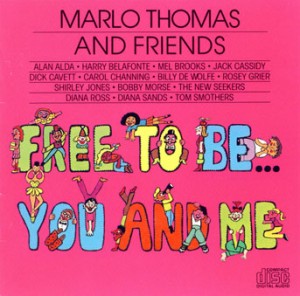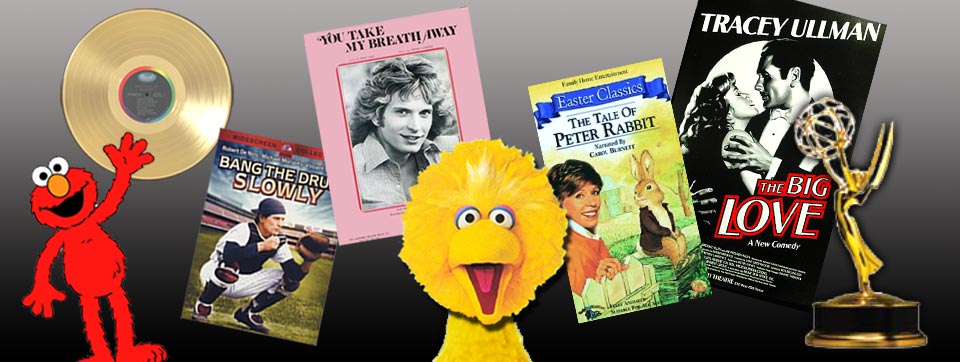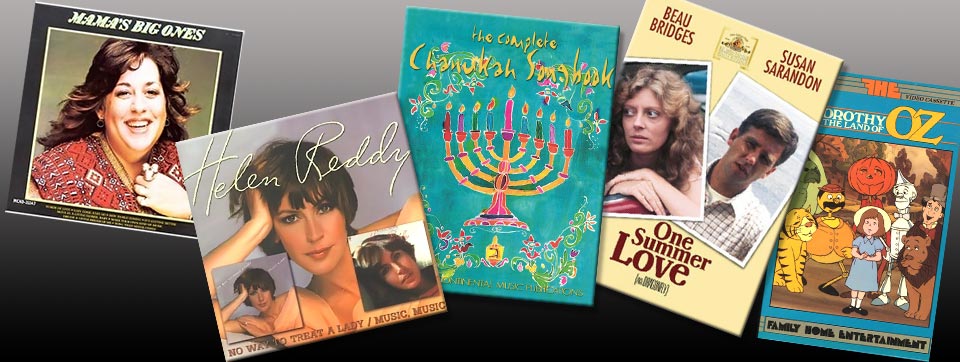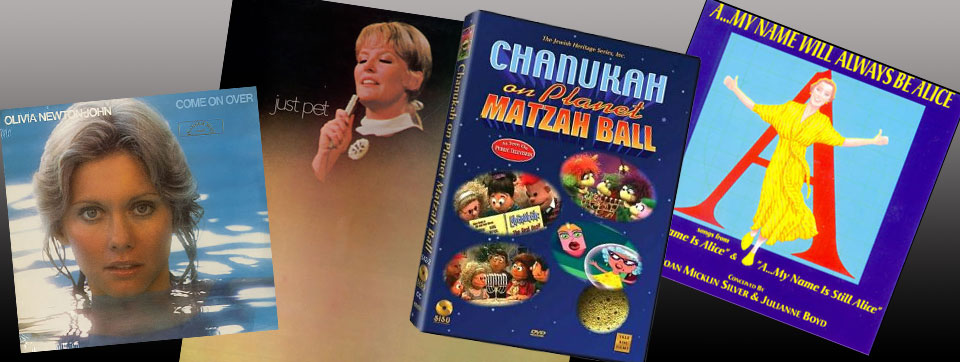 What do Marlo Thomas, Diana Ross, Michael Jackson, Roberta Flack, Dionne Warwick, Mel Brooks, Rosey Grier, and Harry Belafonte have in common? They all performed on the million selling record and/or Emmy winning special, “Free To Be…You And Me.” I was the Music Director and composed the title song and four others for the landmark project and I am going to tell you, from the beginning, how we created the music.
What do Marlo Thomas, Diana Ross, Michael Jackson, Roberta Flack, Dionne Warwick, Mel Brooks, Rosey Grier, and Harry Belafonte have in common? They all performed on the million selling record and/or Emmy winning special, “Free To Be…You And Me.” I was the Music Director and composed the title song and four others for the landmark project and I am going to tell you, from the beginning, how we created the music.
Free To Be…You And Me, Making The Music For A Classic
Free To Be – Part 7: Rosey Grier
From 1955 to 1966 Rosey Grier was a 300-pound professional football player, first for The New York Giants and then for The Los Angeles Rams. It was the late lyricist Bruce Hart who had the brainstorm that Rosie would be the ideal choice to sing Carol Hall’s pretty, gentle song, “It’s Alright To Cry.” We sent him a recording of the song and Bruce, his wife Carole and I flew to Atlanta to meet with him in a recording studio.
When I played the song, he said “Can’t you put a beat to it?” He began stomping his foot in tempo. I took the percussive sound and sat down at the piano and improvised an arrangement based on that rhythm. He smiled broadly and said “Yeah, that’s it.” I incorporated that feeling into the final arrangement for the record. On first hearing, Carol Hall was not too pleased with what I’d made out of her simple song, but when she saw what Rosie did with it and how well it fit his musical sensibilities, she changed her mind. Two years later I kept most of that arrangement for the television version of Free To Be (although I added some instruments). And the director chose for his first shot, a close-up of Rosie stomping his foot, just as he had in the Atlanta studio.
In November, 2012, I was a guest on John Schaefer’s program Soundcheck on National Public Radio. I was in the studio with John, and Carol Hall and Rosey spoke by phone. Rosie spoke excitedly about the children and adults who to this day tell him what his performance of “It’s Alright To Cry” meant to them. Carol Hall had never met him and took the opportunity to thank him for bringing his warm personality to the song. She said “I thing I’m going to cry – I’m crying,” and John Schaefer, not losing a beat, said “It’s alright to cry.”
Free To Be – Part 6: Dionne Warwick
Dionne Warwick recorded many hits during the 60s and 70s. She was most associated with the songs of Burt Bacharach and Hal David. Bacharach has a very distinctive style. He uses wide leaps between notes, unexpected phrase lengths and unusual meters. Warwick became very comfortable with his musical style and learned new songs quickly.
For the television version of Free To Be, I was given a poem by Elaine Laron titled “The Sun And The Moon,” and asked to compose music for it. (The song is sometimes mistakenly called “I’d Rather Be The Sun.”)
After I’d composed the music I played it for Marlo and Carole and Bruce and they were very pleased with it. I sent Dionne a tape and spoke to her by phone to set a key. Then I wrote the arrangement and recorded the orchestra in Manhattan. I used strings and reeds to give the song the sound i thought the music and words required. For the vocal I took the tape to a recording studio in New Jersey and overdubbed Dionne there.
I immediately knew we had a problem. Dionne was accustomed to Bacharach’s unique composing techniques and they affected her singing of “The Sun And The Moon.” Of course she was by then a natural at singing songs like “I Say A Little Prayer” and other great Bacharach-David songs, but I didn’t compose “The Sun And The Moon” to be sung with pop inflections. I interrupted the recording several times and Dionne seemed to be running out of patience.
I had had a similar experience when Patti LaBelle appeared on Sesame Street and sang my song “Take The Hand of Someone You Love” (lyrics by Mark Saltzman). It’s possible she had spent little or no time rehearsing it, and it did require rehearsing. She was singing live to the recorded band and took many liberties with the melody and I stopped the shoot several times and corrected her. This did not endear me to her. By the end of the afternoon we had a very happy composer and I think Patti was happy too because, although she had to stretch her comfort zone, the song looked and sounded great.
We had a similar happy ending with Dionne. She was flexible enough to make me happy and still enjoyed singing “The Sun And The Moon.”
Free To Be – Part 5: Michael Jackson and Roberta Flack
The Free To Be…You And Me record was released in November 1972. It attracted a great deal of attention and we were soon at work on a television version for ABC. We decided to adapt my song “When We Grow Up” (lyrics by Shelley Miller) into a duet and ask Michael Jackson and Roberta Flack to sing it. They both agreed, and Shelley made some changes in the lyrics (See Part 3: Diana Ross) and we had our duet.
I had a bumpy start with Roberta Flack. I was working on the arrangement for “When We Grow Up” in my hotel room and the phone rang and I found myself listening to a tirade from Ms. Flack. “I’ve been in LA for two days and no one has called me. I am not used to this kind of treatment!” Of course, no one had told me, as composer and Musical Director, to send a basket of goodies to her room and stock the mini-bar. I apologized for the slight and called everyone I could think of to give the diva some stroking.
Michael was an exuberant, talented, friendly kid when I worked with him. This is all the more remarkable in light of what we now know was frequent mental and physical abusive treatment by his father.
I met Roberta and Michael for the first time in a recording studio in LA and we rehearsed and recorded their voices for playback on the video stage at ABC. I had spoken to them by phone to set a key before I left New York.
They both impressed me with their musicianship and ability to learn quickly and they knew intuitively how to imbue their characters with just the right amount of child-like fun. They were very natural together and believable as kids, even though Michael was 14 and Roberta was 33. I was happy to discover that their voices blended beautifully. The irony of Michael singing “we don’t have to change at all” echoed in his later years.
At the instrumental session for the record I had used two flutes, piano, two guitars, bass, drums, and finger cymbals. For the television version, I added a small string section for the third verse.
With an imaginative set by Broadway legend Tony Walton and direction by the multi-talented Bill Davis, “When We Grow Up”was one of the standout segments of Free To Be.
Free To Be – Part 4: Mel Brooks
Mel Brooks is a one-of-a-kind comic talent, an explosively funny writer and actor. His films and shows are unlike any others.
The late Ed Kleban, a superb songwriter who wrote the lyrics for A Chorus Line, was asked to write a song for the television version of Free To Be. His song, “Let’s Hear It For Babies,” was sung by Mel and conceived as a puppet production number in the style of Busby Berkely, the great director and choreographer of the 1930s. I had prerecorded the band track in New York and taken it to Los Angeles to overdub Mel’s voice. In contrast to some of the smaller bands I used for Free To Be, for this song I had a full Broadway-size orchestra and it sounded fabulous.
Ed had written a catchy vamp and Mel sang it a cappella before the band came in. Naturally, he had heard the arrangement in advance and he had to start singing roughly in the same tempo the band would be playing in when it joined him. When we had finished, everything was smooth and it sounded spontaneous.
What was not smooth was the rehearsal process. I met with Mel at Marlo’s house in Beverly Hills. Being a songwriter himself (“Springtime For Hitler,”) he must have realized how terrific Ed’s song was, but he soon began to take liberties with the melody. Either that or he hadn’t completely learned it. Ed was my friend as well as a fellow songwriter and I was determined that the song be sung as written, allowing for a certain amount of personal styling by the singer. But when Mel changed the tune I was quick to correct him and this met with a certain amount of resistance. Finally, he walked out of the room. Marlo entered and said “Stephen, what are you doing?! That’s MEL BROOKS! He’ll leave!” I said “I’m protecting the song; an extraordinary songwriter wrote a great piece of material and I don’t think it can be “improved.” I felt confident in saying “He won’t leave; he’ll come back and learn the song and he’ll be perfect.” I was right. Mel was able to sing the correct notes and still filter it through his comic genius and the song was one of the highlights of the show.
There was a similar situation when Dionne Warwick recorded my and Elaine Laron’s song, “The Sun And The Moon.” More on that in another part of this blog.
Free To Be – Part 3: Diana Ross
One of the main themes that run through Free To Be is the joy of friendship. With this in mind, lyricist Shelley Miller came up with the idea for “When We Grow Up.” Within a few days she gave me a first draft and I showed it to Carole and Marlo. They liked it and gave me a green light to write the music. At that point I didn’t know who the singer would be but I did know I wanted the song to be simple and innocent. I developed an instrumental pattern for two guitars and two flutes before I wrote a note of melody. I found a musical feeling that I could easily float a simple melody over. I played it several times and began to sing the melody as if I had already composed it.
When the song was finished I played it for Shelley, and then Carole and Bruce, and finally, Marlo. Everyone was very happy with it and I recorded a quick piano-vocal demo which was sent to Diana Ross. I was extremely happy when Carole told me that she would sing it on the record.
For most of the songs I pre-recorded an instrumental track in New York and then brought it to the performer on tape to add his/her voice. With “When We Grow Up,” time was tight. We had Ms. Ross’s schedule and we had to leave soon to record her voice at Motown Studios in Los Angeles. I spoke to her on the phone and we set a key. I had already worked out the basic sound of the arrangement and finished it on the plane. I arrived at Motown Studios and thought about the many famous recording artists who had recorded there, none more famous than Diana Ross. I realized that the entire Free To Be project was lifting my career to new heights. I felt confident about my composing skill and enjoyed every minute of it. The musicians began to arrive. In addition to two flutes and two guitars, we had bass, drums, and finger cymbals. We recorded the instruments first and then Diana. In contrast to the amount of rehearsal some of the other songs required, it was clear that she had learned the song and, more important, she intuitively knew that it needed to be sung as I composed, it without much of her unique pop phrasing for which she is so well known. As I remember, she sang it exactly the way I wanted it in one take.
For the TV version of Free To Be, “When We Grow Up” was made into a duet for Michael Jackson and Roberta Flack. Shelley was asked to add something to the lyric about gender stereotypes and she wrote the lines
Michael:
(WHEN WE GROW UP) WILL I BE ON THE MOON?
Roberta:
WELL, IT MIGHT BE ALRIGHT TO
DANCE BY ITS LIGHT, BUT I’M
GONNA GET UP THERE SOON.
I will write more on recording Roberta and Michael and also about the experience of watching them shoot the song at ABC TV studios in Los Angeles.



